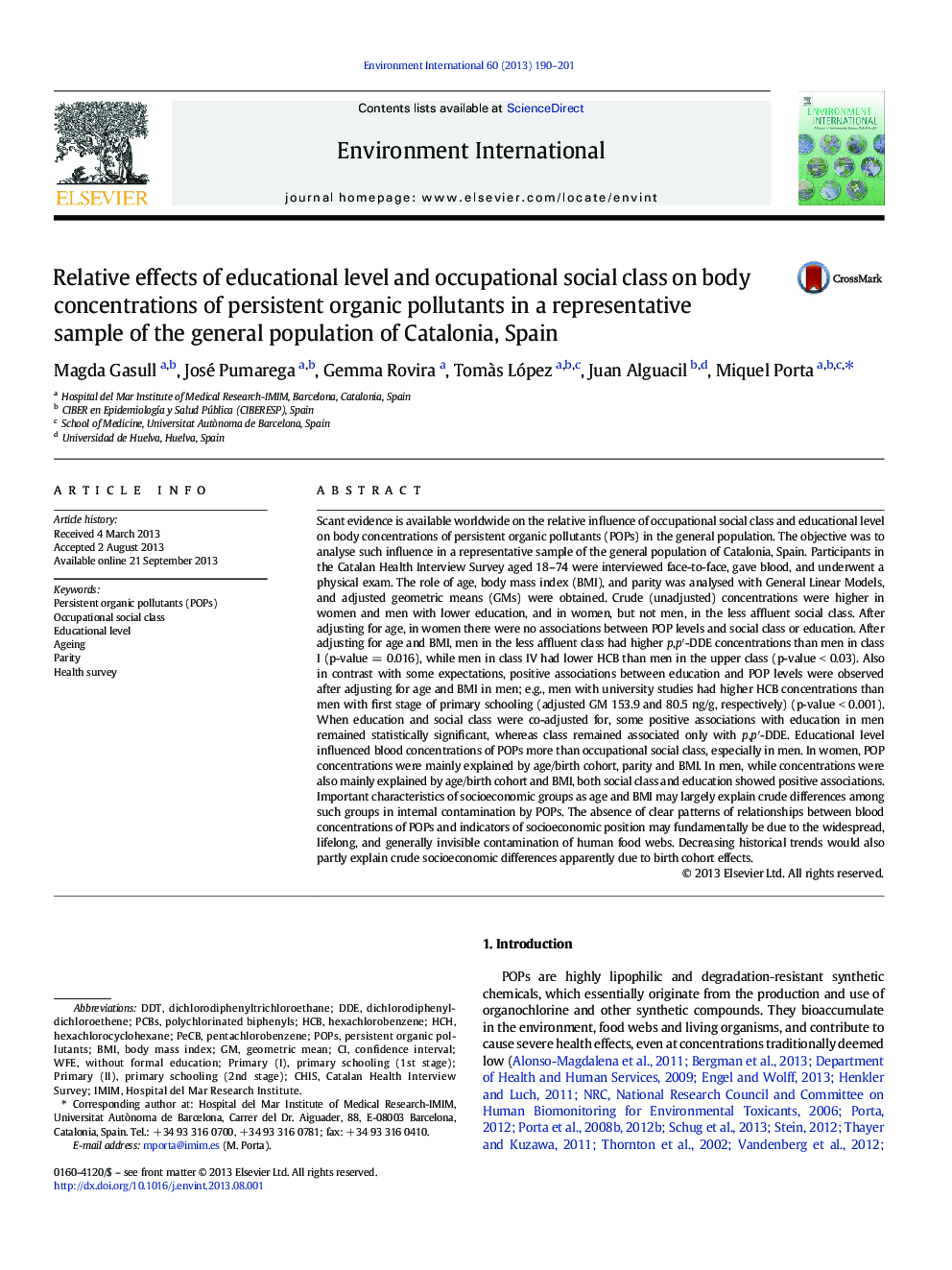| کد مقاله | کد نشریه | سال انتشار | مقاله انگلیسی | نسخه تمام متن |
|---|---|---|---|---|
| 6314204 | 1619068 | 2013 | 12 صفحه PDF | دانلود رایگان |
عنوان انگلیسی مقاله ISI
Relative effects of educational level and occupational social class on body concentrations of persistent organic pollutants in a representative sample of the general population of Catalonia, Spain
ترجمه فارسی عنوان
اثرات نسبی سطح تحصیلات و طبقه اجتماعی شغلی بر غلظت های آلی آلاینده های پایدار در نمونه ی نمونه ای از جمعیت عمومی کاتالونیا، اسپانیا
دانلود مقاله + سفارش ترجمه
دانلود مقاله ISI انگلیسی
رایگان برای ایرانیان
کلمات کلیدی
dichlorodiphenyldichloroetheneCHISPeCBDDEdichlorodiphenyltrichloroethanePCBsHCBHCHPersistent organic pollutants (POPs) - آلاینده های پایدار آلی (POPs)POPs - آلایندههای آلی دیرپاPersistent organic pollutants - آلایندههای آلی دیرپا(پایدار)Parity - برابریHealth survey - بررسی سلامتHexachlorobenzene - بنزن هگزاکلراید، هگزاکلروبنزنPolychlorinated biphenyls - بیفنیل پلیکلر DDT - دیکرو دیفنیل تری کلرواتانAgeing - سالخوردهEducational Level - سطح آموزشیbody mass index - شاخص توده بدنBMI - شاخص توده بدنیconfidence interval - فاصله اطمینانGeometric mean - میانگین هندسیHexachlorocyclohexane - هگزا کلروسیکوه هگزینpentachlorobenzene - پنتاکلروبنزن
موضوعات مرتبط
علوم زیستی و بیوفناوری
علوم محیط زیست
شیمی زیست محیطی
چکیده انگلیسی
Scant evidence is available worldwide on the relative influence of occupational social class and educational level on body concentrations of persistent organic pollutants (POPs) in the general population. The objective was to analyse such influence in a representative sample of the general population of Catalonia, Spain. Participants in the Catalan Health Interview Survey aged 18-74 were interviewed face-to-face, gave blood, and underwent a physical exam. The role of age, body mass index (BMI), and parity was analysed with General Linear Models, and adjusted geometric means (GMs) were obtained. Crude (unadjusted) concentrations were higher in women and men with lower education, and in women, but not men, in the less affluent social class. After adjusting for age, in women there were no associations between POP levels and social class or education. After adjusting for age and BMI, men in the less affluent class had higher p,pâ²-DDE concentrations than men in class I (p-value = 0.016), while men in class IV had lower HCB than men in the upper class (p-value < 0.03). Also in contrast with some expectations, positive associations between education and POP levels were observed after adjusting for age and BMI in men; e.g., men with university studies had higher HCB concentrations than men with first stage of primary schooling (adjusted GM 153.9 and 80.5 ng/g, respectively) (p-value < 0.001). When education and social class were co-adjusted for, some positive associations with education in men remained statistically significant, whereas class remained associated only with p,pâ²-DDE. Educational level influenced blood concentrations of POPs more than occupational social class, especially in men. In women, POP concentrations were mainly explained by age/birth cohort, parity and BMI. In men, while concentrations were also mainly explained by age/birth cohort and BMI, both social class and education showed positive associations. Important characteristics of socioeconomic groups as age and BMI may largely explain crude differences among such groups in internal contamination by POPs. The absence of clear patterns of relationships between blood concentrations of POPs and indicators of socioeconomic position may fundamentally be due to the widespread, lifelong, and generally invisible contamination of human food webs. Decreasing historical trends would also partly explain crude socioeconomic differences apparently due to birth cohort effects.
ناشر
Database: Elsevier - ScienceDirect (ساینس دایرکت)
Journal: Environment International - Volume 60, October 2013, Pages 190-201
Journal: Environment International - Volume 60, October 2013, Pages 190-201
نویسندگان
Magda Gasull, José Pumarega, Gemma Rovira, Tomà s López, Juan Alguacil, Miquel Porta,
